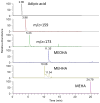In vitro metabolites of di-2-ethylhexyl adipate (DEHA) as biomarkers of exposure in human biomonitoring applications
- PMID: 24016063
- PMCID: PMC4552309
- DOI: 10.1021/tx400215z
In vitro metabolites of di-2-ethylhexyl adipate (DEHA) as biomarkers of exposure in human biomonitoring applications
Abstract
Di-2-ethylhexyl adipate (DEHA) is a common plasticizer used in food packaging. At high doses, DEHA can cause adverse health effects in rats. Although the potential for human exposure to DEHA is high, no DEHA specific biomarkers are identified for human biomonitoring. Using human liver microsomes, we investigated the in vitro phase I metabolism of DEHA and its hydrolytic metabolite mono-2-ethylhexyl adipate (MEHA) and, for comparison purposes, of the analogous di-2-ethylhexyl phthalate (DEHP) and its hydrolytic metabolite mono-2-ethylhexyl phthalate. We unequivocally identified MEHA, a DEHA specific biomarker, and adipic acid, a nonspecific biomarker, using authentic standards. On the basis of their mass spectrometric fragmentation patterns, we tentatively identified two other DEHA specific metabolites: mono-2-ethylhydroxyhexyl adipate (MEHHA) and mono-2-ethyloxohexyl adipate (MEOHA), analogous to the oxidative metabolites of DEHP. Interestingly, although adipic acid was the major in vitro metabolite of DEHA, the analogous phthalic acid was not the major in vitro metabolite of DEHP. Our preliminary data for 144 adults with no known exposure to DEHA suggests that adipic acid is also the main in vivo urinary metabolite, while MEHA, MEHHA, and MEOHA are only minor metabolites. Therefore, the use of these specific metabolites for assessing the exposure of DEHA may be limited to highly exposed populations.
Conflict of interest statement
The authors declare no competing financial interest.
Figures



Similar articles
-
Identification of di-2-ethylhexyl terephthalate (DEHTP) metabolites using human liver microsomes for biomonitoring applications.Toxicol In Vitro. 2015 Jun;29(4):716-21. doi: 10.1016/j.tiv.2015.02.002. Epub 2015 Feb 14. Toxicol In Vitro. 2015. PMID: 25687528 Free PMC article.
-
Wastewater-based epidemiology to assess human exposure to personal care and household products - A review of biomarkers, analytical methods, and applications.Trends Environ Anal Chem. 2020 Dec;28:e00103. doi: 10.1016/j.teac.2020.e00103. Epub 2020 Sep 3. Trends Environ Anal Chem. 2020. PMID: 38620429 Free PMC article. Review.
-
Determination of human urinary metabolites of the plasticizer di(2-ethylhexyl) adipate (DEHA) by online-SPE-HPLC-MS/MS.J Chromatogr B Analyt Technol Biomed Life Sci. 2019 Aug 15;1124:239-246. doi: 10.1016/j.jchromb.2019.06.019. Epub 2019 Jun 17. J Chromatogr B Analyt Technol Biomed Life Sci. 2019. PMID: 31233945
-
Metabolism and urinary excretion kinetics of di(2-ethylhexyl) adipate (DEHA) in four human volunteers after a single oral dose.Toxicol Lett. 2020 Mar 15;321:95-102. doi: 10.1016/j.toxlet.2019.12.006. Epub 2019 Dec 6. Toxicol Lett. 2020. PMID: 31816331
-
Di(2-ethylhexyl)phthalate (DEHP): human metabolism and internal exposure-- an update and latest results.Int J Androl. 2006 Feb;29(1):155-65; discussion 181-5. doi: 10.1111/j.1365-2605.2005.00607.x. Int J Androl. 2006. PMID: 16466535 Review.
Cited by
-
Antiproliferative activity of antimicrobial peptides and bioactive compounds from the mangrove Glutamicibacter mysorens.Front Microbiol. 2023 Feb 17;14:1096826. doi: 10.3389/fmicb.2023.1096826. eCollection 2023. Front Microbiol. 2023. PMID: 36876075 Free PMC article.
-
Identification of di-2-ethylhexyl terephthalate (DEHTP) metabolites using human liver microsomes for biomonitoring applications.Toxicol In Vitro. 2015 Jun;29(4):716-21. doi: 10.1016/j.tiv.2015.02.002. Epub 2015 Feb 14. Toxicol In Vitro. 2015. PMID: 25687528 Free PMC article.
-
Development, testing, parameterisation, and calibration of a human PBK model for the plasticiser, di (2-ethylhexyl) adipate (DEHA) using in silico, in vitro and human biomonitoring data.Front Pharmacol. 2023 Mar 23;14:1165770. doi: 10.3389/fphar.2023.1165770. eCollection 2023. Front Pharmacol. 2023. PMID: 37033641 Free PMC article.
-
Stoffmonographie für Diethylhexyladipat (Di(2-ethylhexyl)adipat, DEHA) – HBM-I-Werte für den Metaboliten Mono-5-carboxy-(2-ethylpentyl)adipat (5cx-MEPA) im Urin von Erwachsenen und Kindern : Stellungnahme der Kommission „Human-Biomonitoring“ des Umweltbundesamtes.Bundesgesundheitsblatt Gesundheitsforschung Gesundheitsschutz. 2023 Jun;66(6):702-712. doi: 10.1007/s00103-023-03715-2. Bundesgesundheitsblatt Gesundheitsforschung Gesundheitsschutz. 2023. PMID: 37306729 German. No abstract available.
-
Wastewater-based epidemiology to assess human exposure to personal care and household products - A review of biomarkers, analytical methods, and applications.Trends Environ Anal Chem. 2020 Dec;28:e00103. doi: 10.1016/j.teac.2020.e00103. Epub 2020 Sep 3. Trends Environ Anal Chem. 2020. PMID: 38620429 Free PMC article. Review.
References
-
- Fasano E, Bono-Blay F, Cirillo T, Montuori P, Lacorte S. Migration of phthalates, alkylphenols, bisphenol A and di(2-ethylhexyl)adipate from food packaging. Food Control. 2012;27:132–138.
-
- Goulas AE, Salpea E, Kontominas MG. Di(2-ethylhexyl) adipate migration from PVC-cling film into packaged sea bream (Sparus aurata) and rainbow trout (Oncorhynchus mykiss) fillets: kinetic study and control of compliance with EU specifications. Eur Food Res Technol. 2008;226:915–923.
-
- Loftus NJ, Woollen BH, Steel GT, Wilks MF, Castle L. An assessment of the dietary uptake of di-2-(ethylhexyl) adipate (DEHA) in a limited population study. Food Chem Toxicol. 1994;32:1–5. - PubMed
-
- Fromme H, Gruber L, Schlurnmer M, Wz G, Bohmer S, Angerer J, Mayer R, Liebl B, Bolte G. Intake of phthalates and di(2-ethylhexyl)adipate: results of the integrated exposure assessment survey based on duplicate diet samples and biomonitoring data. Environ Int. 2007;33:1012–1020. - PubMed
Publication types
MeSH terms
Substances
Grants and funding
LinkOut - more resources
Full Text Sources
Other Literature Sources

